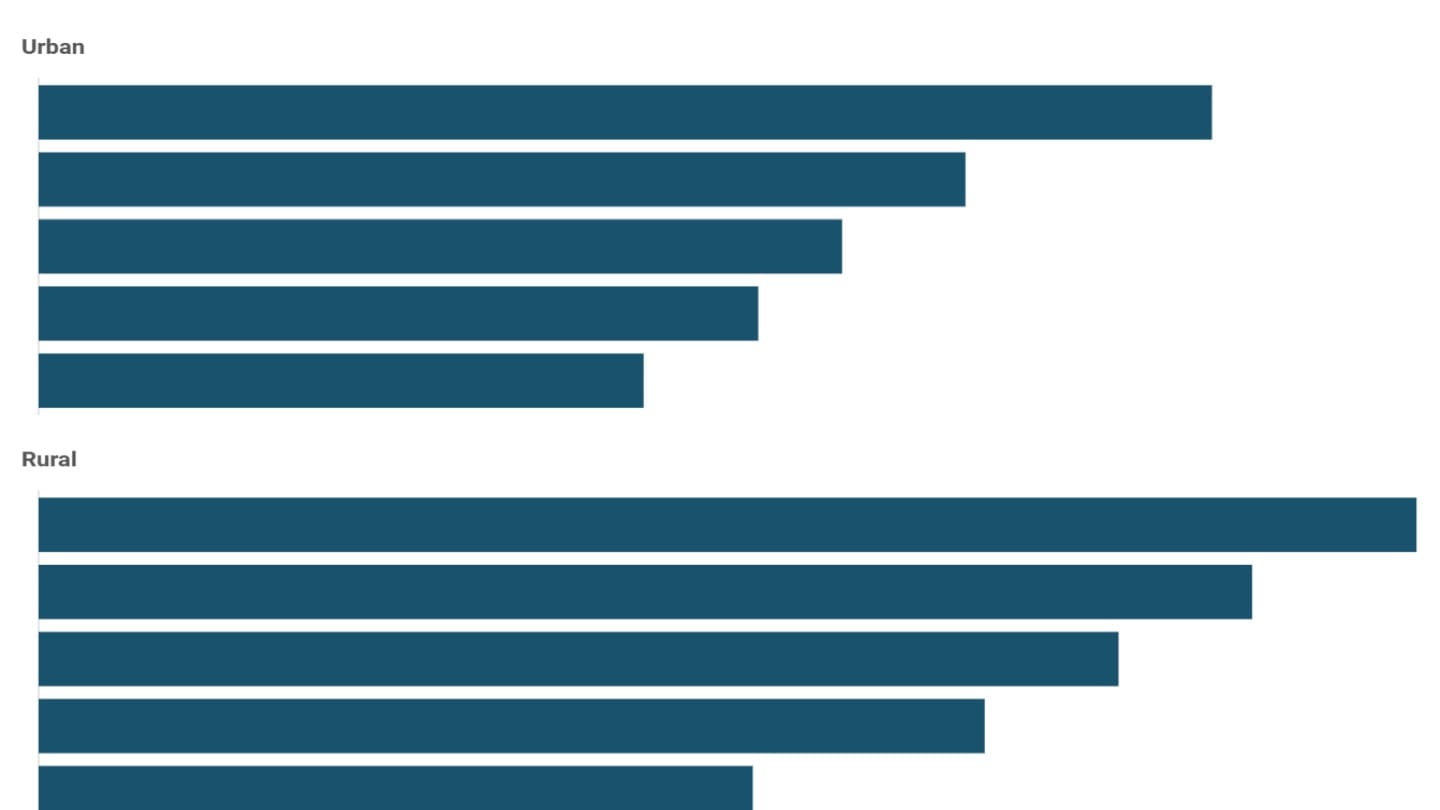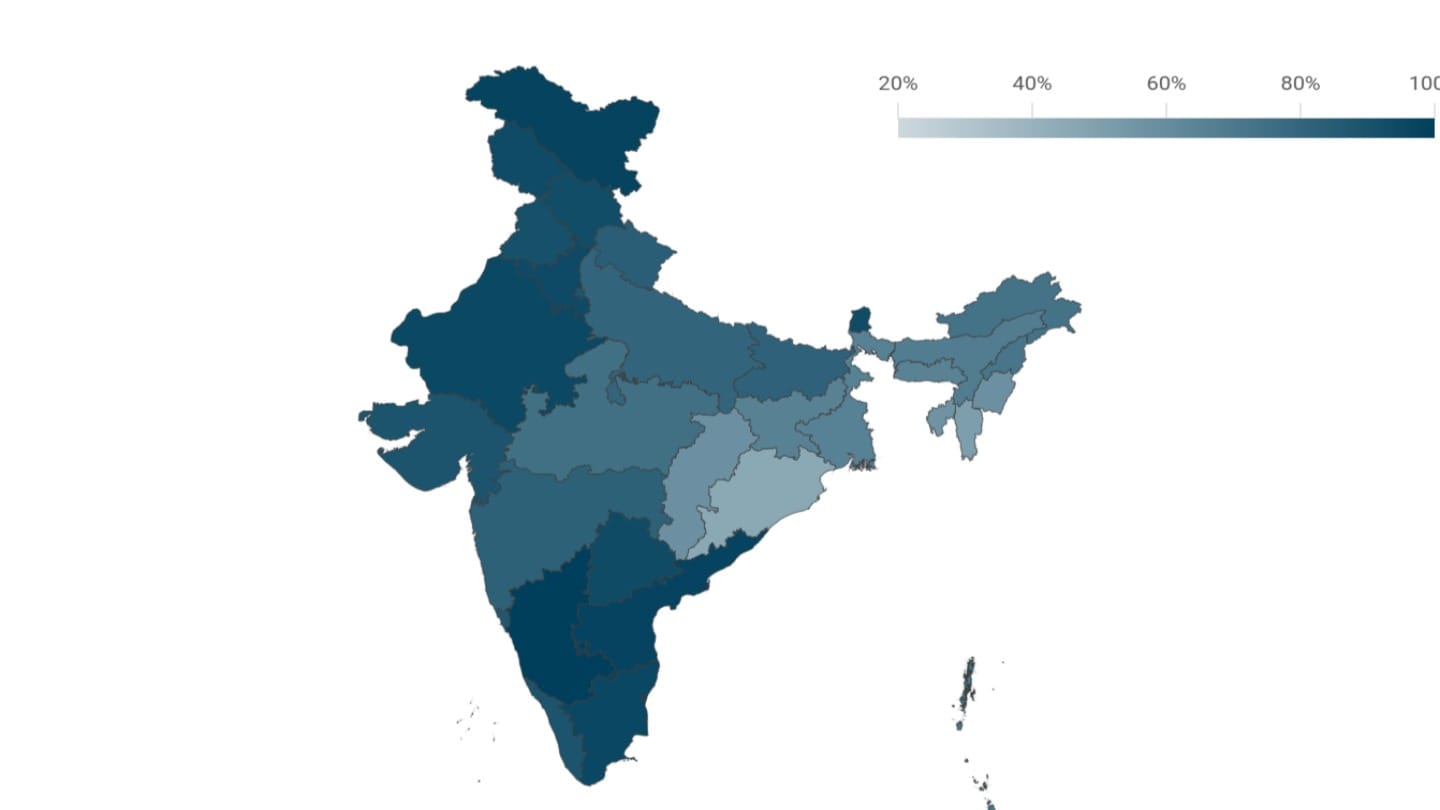Meat consumption in India
Most Indians eat meat, and the share who eat meat is growing over time. Vegetarianism is more prevalent in some states and among some groups.
Meat, poultry, seafood and eggs are widely consumed in India. About eight out of ten people aged 15-49 eat some form of animal sourced protein (excluding dairy).[1] The share of people who eat meat[2] is higher among men, at 87% than among women (75%).
Over the years, the share of Indian adults[3] who eat meat has increased slightly, rising from 74% in 2006 to 80% in 2021.
Who eats meat in India?
The consumption of meat is more common among lower-income groups. Nearly nine out of ten people belonging to the poorest 20% of India's population eat meat, compared to about seven out of ten among the wealthiest 20%.[4]
This difference is larger among women, especially in rural areas. Among women belonging to the wealthiest group in rural India, just over half eat meat, whereas three-quarters of men do.
Consumption patterns also vary by social and religious groups.
Religion also plays a role in dietary habits. Nearly all of the Muslim (99%), Christian (99%) and Buddhists/neo-Buddhist (97%) populations eat meat. Among Hindus, a little over three-quarters consume meat, while Jains and Sikhs have the highest share of vegetarians. Only one-quarter of Jains and half of Sikhs have ever eaten meat.
Among Scheduled Castes (SCs) and Scheduled Tribes (STs), 87% and 88% respectively consume meat, while the figure is lower at 72% for other groups.
Only three states have a vegetarian majority - Punjab, Haryana and Rajasthan. Most coastal states have very few vegetarians, with less than 5% of the population reporting that they had never eaten meat, except in Gujarat, Karnataka and Maharashtra.
What kinds of meat are commonly consumed?
The NFHS classifies different types of meat into 3 broad categories - eggs, fish, and chicken/meat. Eggs are the most widely eaten animal source protein with 78% of people having eaten them, followed by chicken/ meat (75%) and fish (72%).
Most people do not eat meat every day. Overall, one in ten people eat some form of meat daily, while six in ten do so weekly. Both the share of meat consumers and their frequency of consumption are higher in urban areas.
The frequency of consumption across all categories has also increased over time.
For instance, in 2006, nearly half of those who ate eggs consumed them only occasionally. By 2021, this share had dropped to a third, while the share of weekly egg consumers rose to over half. In 2006, a third of consumers of chicken/ meat ate it weekly, but by 2021, this had increased to over half.
Spending on meat
On an average,[5] an individual spends Rs. 216 per month on meat items, accounting for 10% of total food expenditure.[6] In rural areas, the average spending is just over Rs. 200 per month, while in urban areas, it is close to Rs. 250 per month.[7]
The share of total food expenditure spent on meat on an average has doubled from 5% in 1988 to 10% by 2023.
Among rural households, the share of food expenditure on meat increases with income. However, in urban areas, this trend is reversed, with the wealthiest groups spending a smaller share of the net food expenditure on meat items.[8]
In some states, a significant share of the average food expenditure is on meat. The northeastern states, for instance, spend almost 20-25% of their food budget on eggs, fish, and meat-the highest in the country. In West Bengal and Kerala, more than 20% of the food budget goes toward meat. In fact, in Kerala, Goa and Nagaland, spending on meat is twice as high as spending on vegetables.
[1] National Family Health Survey 5, 2019-21. The survey asks if the respondent has ever consumed egg, fish, and chicken/meat and the frequency of consumption (daily, weekly or occasionally) is recorded. This question is asked separately in men's and women's questionnaires. It includes responses from over 100,000 men at the state level and more than 700,000 women. To determine overall consumption prevalence, these datasets were merged, selecting men aged 15-49 from the men's dataset and women in the same age-group from households under the state module from the women's dataset.
[2] In this piece, the term "meat" refers to any form of meat, poultry, seafood, and eggs, unless stated otherwise.
[3] Refers to people aged 15-49, reflecting data availability from the NFHS.
[4] The NFHS measures a household's overall living standard based on assets (like TVs and bicycles), housing materials, and access to water and sanitation to categorise the population into five wealth index groups.
[5] Average calculated across all households, including those that did not consume meat in the week prior to the survey.
[6] Household Consumption Expenditure Survey, 2023-24.
[7] Urban areas have a slightly higher share of people who have ever consumed meat, according to NFHS 5. However, based on the HCES 2023-24, regular consumption is higher in rural areas. In the week prior to the survey, 74% of rural households reported purchasing meat items, compared to 69% in urban areas.
[8] The richest urban population has the lowest share of people who reported consuming meat (68%) in the 7 days prior to the survey. The average is calculated across all households, including those that did not consume meat in the week prior to the survey.




